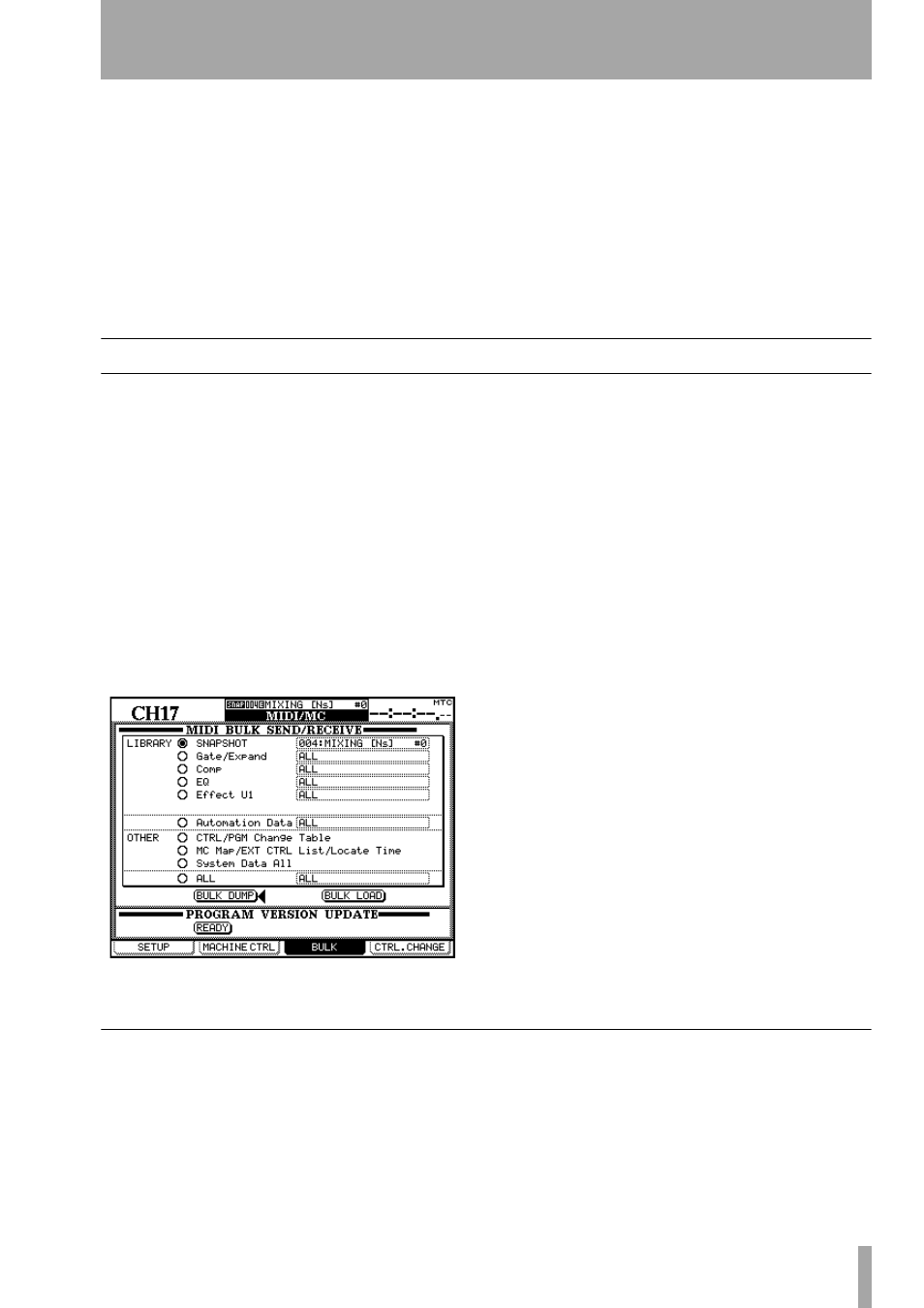12 – midi, Bulk dumps, Bulk transfer of data from the dm-24 – Teac DM-24 User Manual
Page 95

TASCAM DM-24 Reference Manual
95
12 – MIDI
The DM-24 can be used for control of MIDI devices,
as well as being controlled by them.
In the section on machine control, it is explained how
the DM-24 can be used to control MIDI devices,
using the PODs to transmit different common Con-
trol Change messages on a single channel (“MIDI
controllers” on page 93) or using the faders to send
the same Control Change message on up to 16 differ-
ent MIDI channels (“MIDI faders” on page 93).
In the section on Machine Control, it is also
explained how the DM-24 can be set up to use or
ignore certain MIDI messages, as well as other MIDI
setup parameters (“General MIDI parameters” on
page 84 and “MIDI filtering” on page 84).
The DM-24 can also be controlled by means of MIDI
messages, etc. as well as being able to save and load
library settings, etc. to and from MIDI bulk storage
devices, by using System Exclusive bulk dump
messages.
Bulk dumps
This provides a convenient way for you to store and
recall the settings you make on the DM-24. Since
most sequencer programs, etc. allow you to save such
System Exclusive dumps on floppy disks or other
portable media, you can easily carry the settings for a
project (including all the automated mix moves)
between different facilities equipped with DM-24s.
In addition, if you have two DM-24 units side-by-
side, it is possible to use this facility to transfer set-
tings from one unit to another.
In each case, the
MIDI OUT
of the DM-24 must be
connected to the MIDI IN of the remote unit, and the
MIDI IN
of the DM-24 to the MIDI OUT of the
remote unit.
Enter the
MIDI BULK SEND/RECEIVE
screen by pressing
MIDI/MC
key with the
SHIFT
indicator lit.
Then use soft key 3 to bring up this screen.
It is possible to save the library memories for snap-
shots, dynamics processors (gates and expanders, and
compressors), the EQ library entries and the two
internal effector entries. These can be saved as
ALL
entries in that library, or individually).
Automation data can also be stored in this way (indi-
vidual banks or
ALL
).
Other options are the Program Change table (“Pro-
gram Change values” on page 84) and the Control
Change tables (“Control Change messages to and
from the DM-24” on page 96) stored together as
CTRL/PGM Change Table
.
The Machine Control Mappings, the external control
list and the location time memories (“Location mem-
ories” on page 85) can also be selected for MIDI
dump storage (
MC Map/EXT CTRL LIST/Locate Time
).
All system data can also be dumped in this way
(
System Data All
).
Last on the list is the
ALL
option, where all the above
options—the contents of all libraries as well as the
other data described above (
ALL
), all the library
entries of all the libraries, (
LIBRARY
) or all the library
entries of all the libraries together with the automa-
tion data (
Library+Automation
) can be selected for
dumping.
Bulk transfer of data from the DM-24
Prepare the other MIDI device to receive System
Exclusive bulk data.
Select the data to be transferred from the DM-24.
When the appropriate set of data to be dumped to the
MIDI device has been selected, move the cursor to
the on-screen
BULK DUMP
button, and press
ENTER
.
A popup appears, giving the progress as a percentage
as the data is transferred to the remote bulk device.
The dump process can be halted by pressing any of
the cursor keys.
